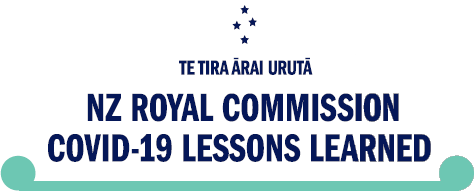7.4 What we learned looking back Ngā akoranga i te titiro whakamuri
1. In combination with the elimination strategy, vaccination was fundamental to the effectiveness of the country’s COVID-19 response.
a. From the first weeks of the pandemic response, vaccination was recognised as the likely key measure that would allow Aotearoa New Zealand to reconnect with the rest of the world while protecting the population from the levels of COVID-19 illness and death seen in other countries.
b. While Aotearoa New Zealand’s vaccination programme started slightly later than those in some other countries, it quickly achieved very high coverage: more than 80 percent of adults had received two vaccine doses by the end of 2021. This meant the vast majority of New Zealanders had been fully vaccinated before they were exposed to COVID-19 infection.
c. The vaccination programme was also successful in ensuring people at highest risk received a third ‘booster’ dose within a few months of their original vaccination. This meant they benefited from high levels of protection at the point New Zealand experienced its first COVID-19 ‘peak’ with Omicron in early 2022.
d. In addition to the protective effect of the elimination strategy, vaccination is estimated to have saved more than 6,500 lives and prevented more than 45,000 hospitalisations from COVID-19 in Aotearoa New Zealand.
2. The vaccine procurement process was appropriate and effective. International relationships were important in securing timely vaccine supplies to support the rollout.
a. Aotearoa New Zealand used a portfolio approach that appropriately invested in several potential vaccine sources to be confident of securing an adequate supply. While this approach eventually resulted in surplus vaccine doses (donated to Pacific countries), it represented a prudent ‘insurance’ policy given the historical expectation that only one in five candidates being developed results in an effective vaccine.
b. Advance purchase agreements were obtained for enough doses to immunise the entire population with a single vaccine – the Pfizer vaccine. While other vaccines were subsequently purchased, Pfizer remains the country’s first-line vaccine option for COVID-19.
c. Good relationships with other countries (particularly Spain and Denmark) were important in addressing supply challenges and ensuring Aotearoa New Zealand had sufficient vaccine to support the national rollout.
3. The Pfizer vaccine underwent full assessment and received provisional regulatory approval prior to being rolled out.
a. Pfizer underwent independent assessment and received provisional approval by Medsafe before being rolled out in Aotearoa New Zealand.
b. The Medsafe assessment process provided assurance about the quality, safety and efficacy of the vaccine for the New Zealand population. The process also allowed regulators to review the most up-to-date evidence, including data not available to regulators in other countries. An expedited review process meant Pfizer received approval before the first doses arrived in the country.
4. An enormous effort underpinned the vaccine rollout, which achieved very high levels of population coverage. At the same time, some opportunities were missed to ensure the vaccine reached vulnerable people as equitably as desirable.
a. The COVID-19 immunisation programme was very effective in quickly delivering high levels of vaccine coverage at an overall population level.
b. The rollout of the vaccine involved difficult trade-offs between the need to manage operational constraints, the desire to vaccinate the population as quickly as possible, and recognition that more tailored approaches would be needed to reach some population groups (including Māori and Pacific communities, and people living in more rural areas). With hindsight, opportunities to ensure more equitable vaccination uptake were missed by not involving Māori, Pacific and community-based providers earlier, in parallel to the main vaccination programme.
c. Once Māori, Pacific and other community-based providers were brought into the vaccine rollout, they were highly effective in supporting vaccine uptake within their communities.
d. Faster vaccine rollout and uptake among Māori and Pacific people would have resulted in fewer hospitalisations and deaths during the Auckland Delta outbreak and likely shortened the final Auckland lockdown.
5. Vaccine hesitancy emerged as a growing challenge to the rollout, fed by exposure to misinformation and disinformation and declining trust in government within some communities.
a. The vaccine rollout was challenged by declining trust and confidence in parts of the population, exacerbated by a proliferation of misinformation and disinformation. The influence of these factors was particularly apparent among younger people, in some Māori and Pacific communities and in rural areas.
b. Providing direct ‘rewards’ (such as vouchers) to encourage vaccination was effective in the short term, but raises ethical challenges – including the impact of perverse incentives and the risk that future vaccination programmes may be less successful if they do not provide such rewards. A better approach is to improve vaccine access and address the root causes of vaccine hesitancy in vulnerable communities. In a future pandemic, direct incentives to boost vaccination should be used with caution.
c. All vaccines have the potential to cause harm to a small number of individuals. While Medsafe and the Ministry of Health sought to keep people up to date with emerging evidence of rare complications, the Inquiry understands there is potential to strengthen the communication of risk at the time people are vaccinated. Doing so would support both informed consent and awareness of any subsequent symptoms that require medical attention.

